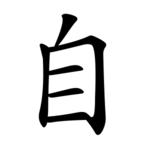Radical 132 or radical self (自部) meaning "self" is one of the 29 Kangxi radicals (214 radicals in total) composed of 6 strokes.
| 自 | ||
|---|---|---|
| ||
| 自 (U+81EA) "self" | ||
| Pronunciations | ||
| Pinyin: | zì | |
| Bopomofo: | ㄗˋ | |
| Gwoyeu Romatzyh: | tzyh | |
| Wade–Giles: | tzŭ4 | |
| Cantonese Yale: | jih | |
| Jyutping: | zi | |
| Japanese Kana: | ジ ji / シ shi (on'yomi) みずか-ら mizuka-ra (kun'yomi) | |
| Sino-Korean: | 자 ja | |
| Names | ||
| Japanese name(s): | 自/みずから mizukara | |
| Hangul: | 스스로 seuseuro | |
| Stroke order animation | ||
 | ||
In the Kangxi Dictionary, there are 34 characters (out of 49,030) to be found under this radical.
自 is also the 137th indexing component in the Table of Indexing Chinese Character Components predominantly adopted by Simplified Chinese dictionaries published in mainland China.
Evolution
edit-
Oracle bone script character
-
Bronze script character
-
Large seal script character
-
Small seal script character
Derived characters
edit| Strokes | Characters |
|---|---|
| +0 | 自 |
| +1 | 臫 |
| +4 | 臬 臭 |
| +6 | 臮 臯 (=皋 -> 白) 臰 |
| +9 | 臱 |
| +10 | 臲 |
Sinogram
editThe radical is also used as an independent Chinese character. It is one of the Kyōiku kanji or Kanji taught in elementary school in Japan.[1] It is a second grade kanji[1]
References
edit- ^ a b "The Kyoiku Kanji (教育漢字) - Kanshudo". www.kanshudo.com. Archived from the original on March 24, 2022. Retrieved 2023-05-06.
Literature
edit- Fazzioli, Edoardo (1987). Chinese calligraphy : from pictograph to ideogram : the history of 214 essential Chinese/Japanese characters. calligraphy by Rebecca Hon Ko. New York: Abbeville Press. ISBN 0-89659-774-1.
- Lunde, Ken (Jan 5, 2009). "Appendix J: Japanese Character Sets" (PDF). CJKV Information Processing: Chinese, Japanese, Korean & Vietnamese Computing (Second ed.). Sebastopol, Calif.: O'Reilly Media. ISBN 978-0-596-51447-1.
External links
editWikimedia Commons has media related to Radical 132.